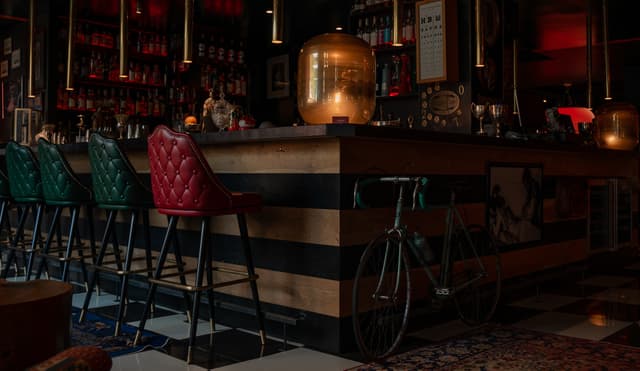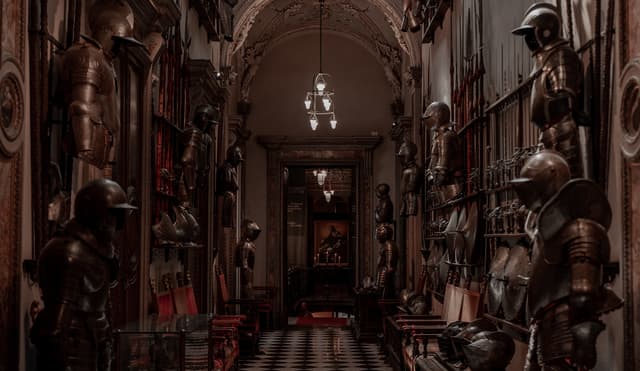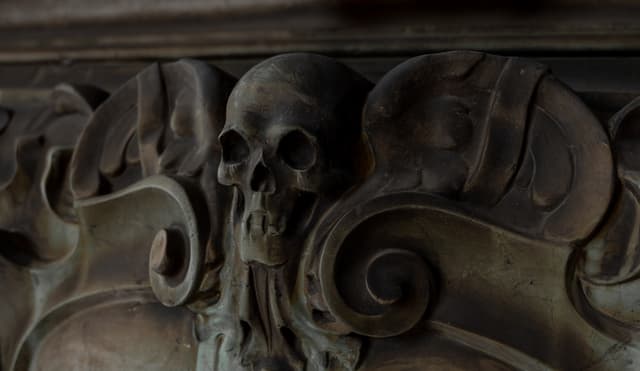The Alternative Guide to Milan Map
Save for Later
Share
The Alternative Guide to Milan Map
The Alternative Guide
Welcome to The Alternative Guide to Milan Map featuring the 23 best dark and unusual things to do. My tailored interactive map is perfect for when you are out on your travels, including my full city guide, photographs and location details all in one place.
Click to discover Milan through an alternative lens as we step off the beaten track and unearth hidden gems and curiosities that are often left undiscovered unless you know a local.
Featuring 23 unexpected, gothic and one-of-a-kind locations, I guarantee the guide will make for a memorable yet extraordinary experience to complete your visit to Italy's historic city.
In my interactive map I reveal my black book of favourite places to visit including detailed accounts of each location, historic tales and of course my top travel tips.
This guide was made to inspire you to wander from the usual tourist path, whilst providing a comprehensive guide to inspire fellow off-beat adventurers who intend to visit Milan.
Please feel free to get in touch if you have any questions.
Thanks, Victoria
IG @thealternativeguide_
Updated ago
7
Share
Hotel recommendation

Aethos Milan
@thealternativeguide
Full of character and charm, this small boutique hotel creates the illusion of stepping into someone’s well curated home, incorporating a selection of hand-picked vintage furniture, abstract artwork and a plethora of collectables and curios, which have all been carefully selected over the years.
Set on the outskirts of the city centre, next to the Naviglio Grande Canal, this offbeat hideaway is located just moments from Corso di Porta Ticinese and the Navigli district where the canals are lined with a fantastic selection of local bars and restaurants that are right on your doorstep.
Each of the 32 rooms has its own design and spirit, brimming with unique items sourced from antique shops and flea markets around the world. Some of the room designs are inspired by sport and include vintage memorabilia including old bowling skittles, boxing gloves, roller skates and riding boots whilst others are influenced by specific locations or people. I personally stayed in the JFK suite which was designed in a dark colour palette and included a king size bed, velvet upholstery, a hand-made retro cabinet and a spacious balcony overlooking the courtyard.
To discover the guest rooms you have to walk through the hotel’s atmospheric ‘Doping bar’, which feels like you are stepping into a low-lit antique shop lined with multiple cabinets and shelves filled with trinkets, curiosities and taxidermy. You can even find a giant ostrich in the back! Unfortunately, I didn’t have chance to have a drink at the bar, but I’ve been told they are renowned for their speciality cocktails!
Two contrasting things which really impressed me about the hotel was the gym and the breakfast. The fitness studio was nicely designed and included a good selection of equipment. And if you have breakfast included, it’s served in the restaurant each morning and offers a well-stocked buffet of savoury and sweet treats, plus you can order more substantial dishes from their à la carte menu. Whilst another nice surprise was their excellent barista coffee menu.
The hotel certainly doesn’t follow the conventional design of many other well-known hotels in the area, which is why I would recommend it as a wonderful option for your alternative stay in Milan!
Add to
Details
Things to do

San Bernardino alle Ossa
@thealternativeguide
During the Middle Ages the area around Via Brolo was outside of the city walls and mainly included woodland that was used for cultivation and hunting by the then Archbishop. In 1145, following a request from an esteemed citizen, a hospital was built near the Santo Stefano Maggiore Church. A cemetery was then put in place to bury the casualties from the hospital, but as time went on the modest burial site became overwhelmed and a small ossuary was constructed to relocate the bones from the cemetery and the hospital. This led to the formation of San Bernardino alle Ossa which was followed by the creation of the church in 1269.
From the exterior there’s nothing to suggest there’s anything of interest or unusual about this typical Lombard Gothic church, but as you walk through the main entrance and down a short corridor you will discover the hauntingly beautiful ossuary chapel, which contains hundreds of human skulls and bones arranged in complex designs and patterns.
It is a truly astonishing artistic display of baroque design with the bones creating religious symbols such as crosses on the walls and decorative motifs that lead one’s eye up to the celling. The intricate design is thought to be the work of local monks and dates back to the time of the ossuary’s reconstruction in 1750, (which took place after the bell tower of the nearby Basilica di Santo Stefano Maggiore collapsed onto the vault due to a fire).
Some sources say that whilst one side of the ossuary holds the remains of charitable beings, the other side contains those who suffered violent deaths having been punished for their crimes.
The ceiling is decorated with magnificent frescoes by the Venetian painter Sebastiano Ricci. Titled “The Triumph of Souls in a Flight of Angels” the artwork acts as a symbolic piece depicting the journey into the afterlife. The contrast between the macabre lower half of the room and the enlightening frescoes creates a rare juxtaposition and a captivating visual example of memento mori.
The ossuary is free to visit and is a unique and quite unforgettable experience. So much so, that even King John V of Portugal was so taken by the sight that he built an exact copy in Evora, near Lisbon.
Add to
Details

Bagatti Valsecchi Museum
@thealternativeguide
The family mansion of Bagatti Valsecchi showcases an extraordinary collection of rare and unique artefacts, which come together to create a fascinating museum experience. The idea to restyle their family home came from the two brothers, Fausto and Giuseppe Bagatti Valsecchi who both shared in a fascination of the 15th & 16th centuries and collecting renaissance artefacts.
The two brothers were very close but in fact had very different personalities. Fausto was known for being fond of high society and parties whilst Giuseppe was a more reserved family man. Despite their differences, it didn’t detract from their shared love of the renaissance period and their desire to create a neo-renaissance style home, which unbeknown to them would eventually becoming a living museum.
In the 1880’s the brothers decided to renovate their old ancestral mansion located in the fashion district of Montenapoleone and started to procure items of medieval art, period furniture, rich Italian renaissance works, European renaissance armour and weapons, amongst many other collectable possessions. Their goal was to create an exhibition space inspired by the Lombardy 15th century mansions.
There are several halls, galleries and spaces to explore within the museum, which are all filled with exquisite curiosities and stunning pieces of art.
A couple of my favourite rooms where the Grand Salon, which is the largest room in the house featuring a double-height ceiling embellished with golden pine cones and walls enriched by a precious 19th century tapestry, which are customised with the Bagatti Valsecchi coat of arms. If you look closely around the door frames you can also find some fantastic carvings including skulls and crossbones, hourglasses and snakes. The second of my favourite rooms was the antique Arms’ Gallery where the brothers displayed their collection of shields, armour and weapons, that mostly consisted of blades, which further depict the renaissance era the brothers were pursuing. Not only can you admire the hundreds of historic artefacts within the museum but it’s also worth noting that the interiors of the house have all been preserved and are completely authentic.
After the brother’s passed away the house continued to be inhabited by their heirs until 1974 when the Bagatti Valsecchi Foundation was established and the house turned into the museum in 1994. The museum hosts an extraordinary atmosphere of extreme luxury and splendour, whilst at the same time featuring some of the most wonderful curiosities you will find in Milan.
Add to
Details

Monumental Cemetery
@thealternativeguide
This beautiful and artistic garden cemetery was designed by Carlo Maciachini in 1866 and hosts numerous pieces of striking funerary art in the form of elaborate sculptures, monuments and mausoleums.
As you walk up to the gates you will see the black and white striped Famedio, which translates from Italian to mean ‘funerary temple’. Inside the neo-medieval structure, you’ll discover the tombs of notable figures and honoured citizens who have made Italy famous through their works or actions. In the centre of the Famedio there’s the tomb of Alessandro Manzoni, the acclaimed writer of the 19th century novel ‘The Betrothed’. Housed under an impressive gothic-style ceiling with an elegant large rose window and decorative motifs, his burial room is extremely impressive for its scale and design.
From Manzoni’s tomb, the Hall of Fame extends from either side and is absolutely fascinating to walk around. One particular monument to note is located in the very Northwest corner, dedicated to Carcano. The remarkable design showcases an imposing carving of an angel with a gold mosaic backdrop and if you turn your gaze to the front of the monument in the lower half you will discover a wonderful memento mori example of a winged skull carving. Whilst walking through the Hall of Fame don't forget that many of the monuments are also positioned on its exterior facing outwards.
Continuing into the grounds of the cemetery there’s approximately 25 hectares to cover and as well as the important personalities of Milan, the cemetery is also a burial place for common Milanese people.
Unless you have all day, you will be hard pressed to see everything so I would recommend concentrating on the central avenue and taking whichever paths spike your curiosity. Dotted around the cemetery you can also find photographic boards that indicate on a map where to locate some of the most important and artistic graves. I found this particularly helpful during my visit and based my walk around the locations shown.
One of the most interesting gravestones I found was situated along the central avenue on the lefthand side when walking North. It portrayed a man holding a scythe on top of the tomb, no doubt depicting the collection of the soul who had passed. I also found the area around Antonio Bernocchi’s monument held even more classical works of art and several large-scale mausoleums. Bernocchi’s final resting place consists of a pillar which represents the Tower of Babel, symbolising human arrogance and rebellion and close by you’ll also discover Carlo Borghi’s iconic grave showcasing an old man with wings resting his elbows on the tombstone.
Wandering over to the West side of the cemetery, you’ll encounter the magnificent tomb of the Campari family and discover more of the lesser-known graves like the one depicting the head of medusa, displayed on the grave of a young aviator.
I personally didn’t book a tour, I just wandered around admiring the landscape and stopped when something caught my eye. If you are pressed for time and are keen to learn more about the history of this astonishing site, then I would highly encourage you to look at booking a private guide.
Add to
Details

Buy to unlock full guide
Access all the local insights and recommendations from @thealternativeguide when you purchase this guide.
ABOUT THE AUTHOR
The Alternative Guide
Hi there, I'm Vicky founder of The Alternative Guide.
Every time I travel to a new city I make a list of unusual places, quirky stores, speciality coffee shops, dark museums, independent eateries, one-off street art and any other off the beaten track places I can manage to find.
I put www.thealternativeguide.com together to provide an alternative lens on some of the major cities across the world, encourage support for local independents and share my black book of favourite places to visit.
Hopefully this will inspire you to stray from the usual tourist path and at the same time provide a comprehensive guide for fellow off-beat adventurers when travelling to a new city.
Thanks for reading and feel free to reach out to me with any questions.
IG: @thealternativeguide_
What's included
Digital Map
Fully interactive, digital map for finding places nearby
23 places
23 hand-picked places with notes from the creator
DESTINATION(S) COVERED
Milan, Metropolitan City of Milan, Italy
FOCUSES AND THEMES
Architecture
Art
Boutique
Design
History
People & Culture
Slow Travel
Format
Guide
Guides typically include detailed information and how-to’s about a destination as well as suggested places to try.
COMMON QUESTIONS
What is Thatch?
Thatch is an online marketplace that provides instant access to thousands of vetted local experts and premium travel guides - making it the easiest and most affordable way to take high quality trips with less stress.
For travel creators (tastemakers, travel advisors, influencers and local experts) Thatch makes it easy to curate, publish, and sell digital travel guides, itineraries and personalized planning services.
What if I’m not satisfied with my purchase?
How do I access my purchased guides?
Can I access my guide offline?
How often are guides updated?
Can I request a personalized guide or itinerary?
Can I sell my own travel guides and itineraries?
Save for Later
Share